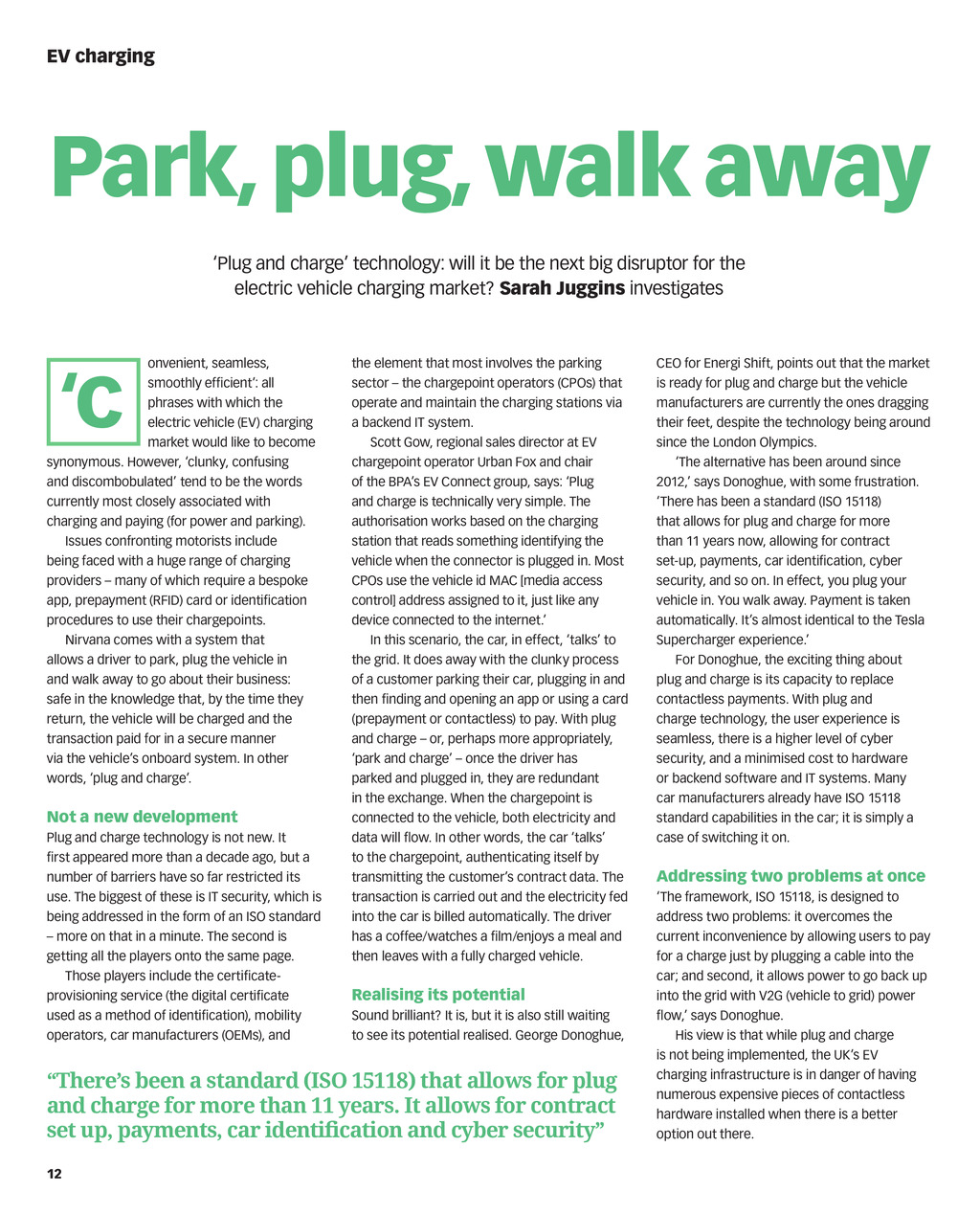


EV charging Park, plug, walk away Plug and charge technology: will it be the next big disruptor for the electric vehicle charging market? Sarah Juggins investigates onvenient, seamless, smoothly efficient: all phrases with which the electric vehicle (EV) charging market would like to become synonymous. However, clunky, confusing and discombobulated tend to be the words currently most closely associated with charging and paying (for power and parking). Issues confronting motorists include being faced with a huge range of charging providers many of which require a bespoke app, prepayment (RFID) card or identification procedures to use their chargepoints. Nirvana comes with a system that allows a driver to park, plug the vehicle in and walk away to go about their business: safe in the knowledge that, by the time they return, the vehicle will be charged and the transaction paid for in a secure manner via the vehicles onboard system. In other words, plug and charge. C Not a new development Plug and charge technology is not new. It first appeared more than a decade ago, but a number of barriers have so far restricted its use. The biggest of these is IT security, which is being addressed in the form of an ISO standard more on that in a minute. The second is getting all the players onto the same page. Those players include the certificateprovisioning service (the digital certificate used as a method of identification), mobility operators, car manufacturers (OEMs), and the element that most involves the parking sector the chargepoint operators (CPOs) that operate and maintain the charging stations via a backend IT system. Scott Gow, regional sales director at EV chargepoint operator Urban Fox and chair of the BPAs EV Connect group, says: Plug and charge is technically very simple. The authorisation works based on the charging station that reads something identifying the vehicle when the connector is plugged in. Most CPOs use the vehicle id MAC [media access control] address assigned to it, just like any device connected to the internet. In this scenario, the car, in effect, talks to the grid. It does away with the clunky process of a customer parking their car, plugging in and then finding and opening an app or using a card (prepayment or contactless) to pay. With plug and charge or, perhaps more appropriately, park and charge once the driver has parked and plugged in, they are redundant in the exchange. When the chargepoint is connected to the vehicle, both electricity and data will flow. In other words, the car talks to the chargepoint, authenticating itself by transmitting the customers contract data. The transaction is carried out and the electricity fed into the car is billed automatically. The driver has a coffee/watches a film/enjoys a meal and then leaves with a fully charged vehicle. Realising its potential Sound brilliant? It is, but it is also still waiting to see its potential realised. George Donoghue, Theres been a standard (ISO 15118) that allows for plug and charge for more than 11 years. It allows for contract set up, payments, car identification and cyber security CEO for Energi Shift, points out that the market is ready for plug and charge but the vehicle manufacturers are currently the ones dragging their feet, despite the technology being around since the London Olympics. The alternative has been around since 2012, says Donoghue, with some frustration. There has been a standard (ISO 15118) that allows for plug and charge for more than 11 years now, allowing for contract set-up, payments, car identification, cyber security, and so on. In effect, you plug your vehicle in. You walk away. Payment is taken automatically. Its almost identical to the Tesla Supercharger experience. For Donoghue, the exciting thing about plug and charge is its capacity to replace contactless payments. With plug and charge technology, the user experience is seamless, there is a higher level of cyber security, and a minimised cost to hardware or backend software and IT systems. Many car manufacturers already have ISO 15118 standard capabilities in the car; it is simply a case of switching it on. Addressing two problems at once The framework, ISO 15118, is designed to address two problems: it overcomes the current inconvenience by allowing users to pay for a charge just by plugging a cable into the car; and second, it allows power to go back up into the grid with V2G (vehicle to grid) power flow, says Donoghue. His view is that while plug and charge is not being implemented, the UKs EV charging infrastructure is in danger of having numerous expensive pieces of contactless hardware installed when there is a better option out there. 12 PN Dec 2023 pp12-15 Lead Feature.indd 12 01/12/2023 12:09